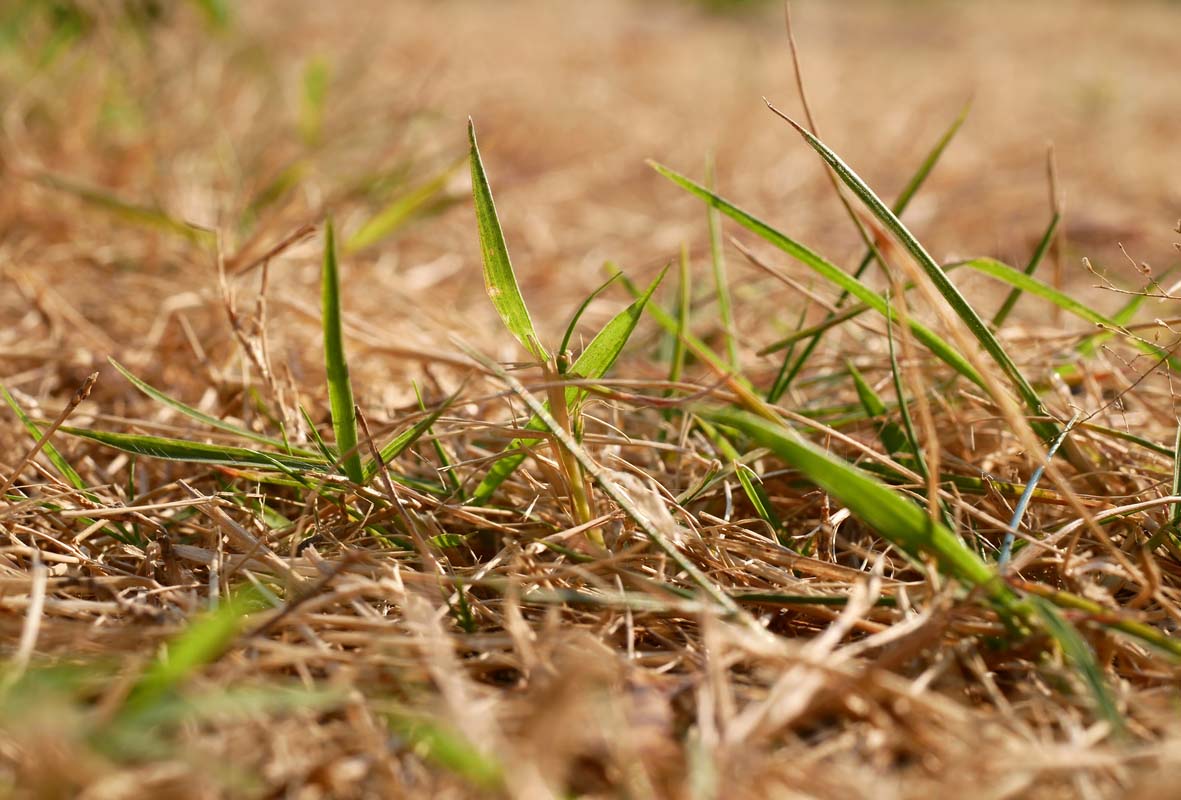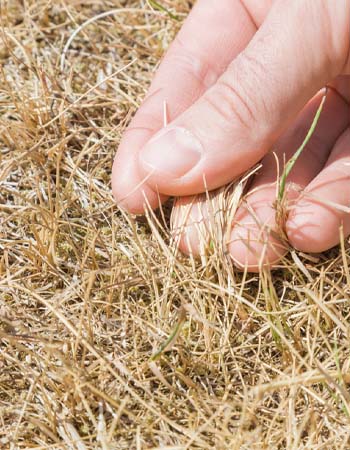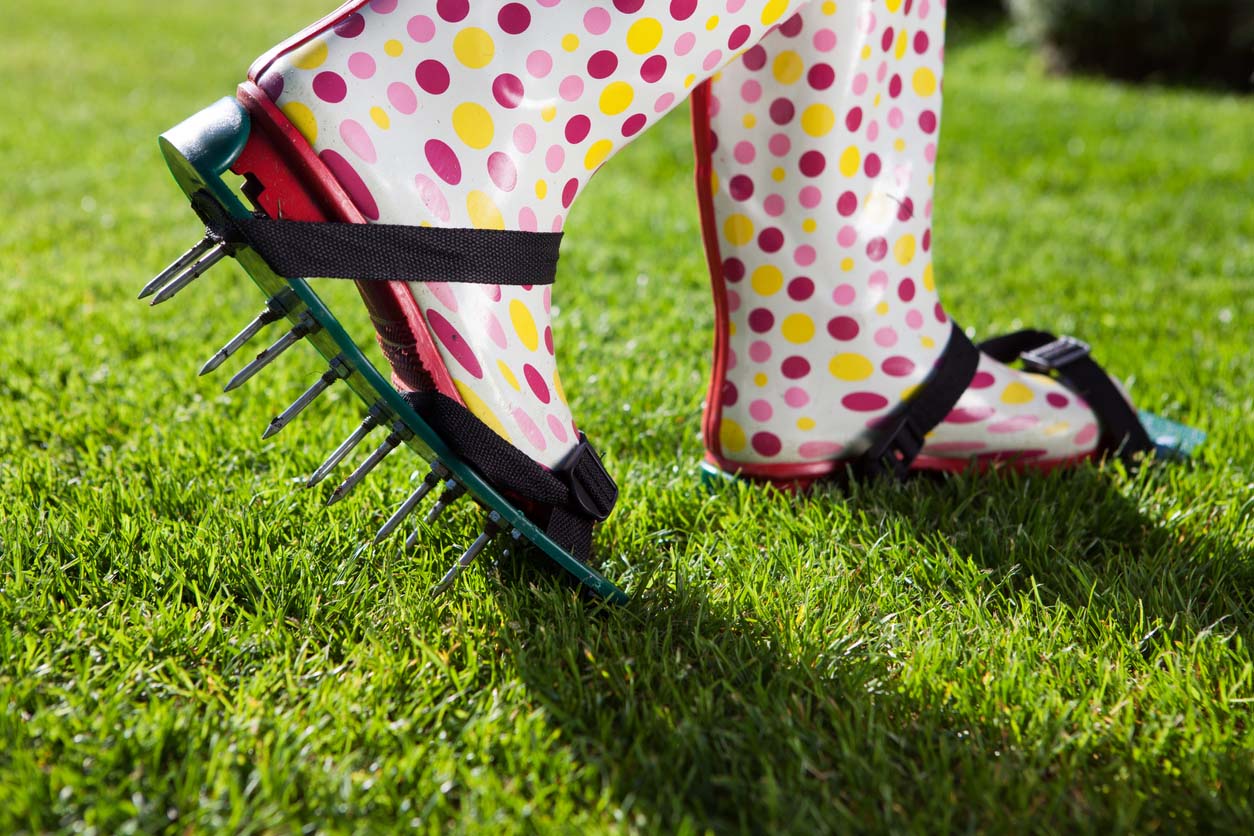

We may earn revenue from the products available on this page and participate in affiliate programs. Learn More ›
Q: It’s been really hot and dry where I live, and I’ve noticed brown patches in my yard. Do I have a drought-stressed lawn? If so, how do I treat it?
A: Depending on the type of grass and the climate, brown patches can definitely be a sign of a drought-stressed lawn. But before researching drought-tolerant lawn alternatives, steps can be taken to save the yard—sometimes without spending a dime. By watering properly, aerating, using one of the best lawn fertilizers, and overseeding, homeowners can get their lawns in tip-top shape in no time. The keys are patience and not overtreating the yard, which can inflict more stress on the grass.

Drought stress happens when a lawn is not receiving enough water for its active growing period.

When late spring and summer hit, it’s easy to start to see the effects of hot, dry conditions on a yard. What once was a lush, green space can turn into a yellow, patchy problem that needs to be addressed. Often, in these cases, grass is in its active growing state but not receiving enough water or nutrients. As a result, the grass goes into a dormant state that shows the stress it’s under. A quick search for “lawn drought-stress images” can help homeowners confirm the problem is drought and not other issues, such as disease or pests.
Drought stress or damage can look like thinning grass, brown patches, and dull grass color.
Since a lot of lawns contain different species of grass, it’s not uncommon for a drought-stressed lawn to have a patchy appearance. This is because some species, such as cool-season grasses, go into a dormant state and turn yellow when water is low and temperatures are high. “Cool-season grasses are less accustomed to heat and prefer humidity,” says Frank Rossi, chief science officer at Sunday Lawn Care.
Having a drought- or heat-stressed lawn doesn’t mean the grass is dead, but rather that lawn drought-stress treatment may be necessary. “By the end of the summer, grass that has been overexposed to consistent heat and drought may have to enter a dormant state just to survive until the next spring,” Rossi says. “This grass will look grayish and then eventually brown or straw-colored.”
Proper watering (and not overwatering) is important for a lawn with drought stress.
When grass looks brown and dull, it may be tempting to excessively fertilize and water, and some may think that a drought-tolerant lawn is one that is constantly being watered. On the contrary; excess watering can actually lead to more damage to a yard.
“If you’re suspecting that the summer is taking a toll on the lawn, the first rule is, like a doctor, do no harm: Stop doing everything,” Rossi says. To combat dry conditions, it’s less important how often the grass is watered and more important to think about how deeply the water is penetrating the soil. Deep, infrequent watering will encourage deeper rooting without stressing the grass. Cool-season grass likely needs about 1 inch of water per week applied either in one watering or split into two.
Mowing higher can help revive a lawn.
A no-cost way to help treat a heat-stressed lawn is to raise the mowing height to between 2 and 4 inches, depending on the type of grass. Because the height of the grass is often proportional to the depth of its rooting, the longer the grass height is, the deeper the roots will penetrate the soil. This allows the grass to access water that’s deeper in the soil. It also gives roots better access to any nutrients in the soil to encourage growth, even in the hot, dry conditions.
Fertilizing the lawn with the right balance of nutrients at the right times can keep it looking healthy.
Even the best organic lawn fertilizer won’t be effective if it’s applied at the wrong time. If fertilizer is applied while the grass is struggling or under stress, it forces the grass to want to grow when its energy should be directed toward staying dormant or fighting off the drought stress. Fertilizer is best applied once the lawn has bounced back, typically in the early to late fall or before the summer heat.
Products such as Sunday Lawn Care Lawn Aid can help fortify grass with the right balance of nutrients to prevent it from becoming heat- or drought-stressed. Lawn Aid can also be applied to a lawn when it’s stressed, although homeowners likely won’t see improvements during the season.

Aerating the lawn can help nutrients penetrate deeper into the soil.
Aerating the lawn involves digging out small holes in the lawn with a mechanical tool. It can help create a drought-tolerant lawn by helping the soil better absorb water and other nutrients it may be lacking in dry conditions. Those who don’t have one of the best lawn aerators can find an affordable handheld one for around $30.

Overseeding the lawn will help make the lawn fuller again.
When a lawn is overseeded, extra grass seed is planted on top of the existing grass to help fill in bare patches, enhance the color, or improve the density of the grass. One of the best fertilizer spreaders can also be used for spreading seed, and this tool makes the process much quicker and applies the seed more evenly. Once applied, the seeds can help promote new grass growth and create a fuller yard. Using a drought-resistant lawn seed that’s suitable for the climate, such as Bermuda grass for warmer regions or tall fescue for cooler regions, can prevent a drought-stressed lawn in the future.
Minimizing foot traffic helps the lawn stay lush.
Regular foot traffic can cause more damage to a drought-stressed lawn since grass blades in stressed conditions don’t spring back up. Whether residents or guests tend to walk specific paths, it’s best to vary the routes so the lawn isn’t damaged further.
Homeowners can consider drought-resistant lawn alternatives.
Many may want to avoid the potential for lawn problems altogether and are considering the cost to convert the lawn to be drought-tolerant. Some drought-tolerant lawn ideas include incorporating other grasses and greens into an existing yard. Grasses like fescue require minimal mowing and hold up well to drought. Microclover doesn’t allow water to evaporate as easily, keeping a yard hydrated for longer. Homeowners can overseed their lawns with clover or fescue or replace their lawns altogether with these lower-maintenance greens. (And for pet parents, clover is impervious to urine, so no need to worry about dead spots on the lawn.)
